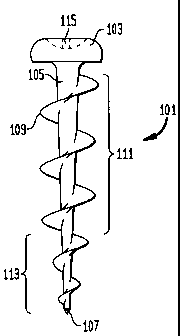Une partie des informations de ce site Web a été fournie par des sources externes. Le gouvernement du Canada n'assume aucune responsabilité concernant la précision, l'actualité ou la fiabilité des informations fournies par les sources externes. Les utilisateurs qui désirent employer cette information devraient consulter directement la source des informations. Le contenu fourni par les sources externes n'est pas assujetti aux exigences sur les langues officielles, la protection des renseignements personnels et l'accessibilité.
L'apparition de différences dans le texte et l'image des Revendications et de l'Abrégé dépend du moment auquel le document est publié. Les textes des Revendications et de l'Abrégé sont affichés :
| (12) Brevet: | (11) CA 2352026 |
|---|---|
| (54) Titre français: | VIS EN FORME DE TARIERE POUR CLOISONS SECHES |
| (54) Titre anglais: | AUGER-LIKE DRYWALL SCREW |
| Statut: | Périmé et au-delà du délai pour l’annulation |
| (51) Classification internationale des brevets (CIB): |
|
|---|---|
| (72) Inventeurs : |
|
| (73) Titulaires : |
|
| (71) Demandeurs : |
|
| (74) Agent: | SMART & BIGGAR LP |
| (74) Co-agent: | |
| (45) Délivré: | 2008-11-18 |
| (22) Date de dépôt: | 2001-07-03 |
| (41) Mise à la disponibilité du public: | 2002-02-08 |
| Requête d'examen: | 2004-06-23 |
| Licence disponible: | S.O. |
| Cédé au domaine public: | S.O. |
| (25) Langue des documents déposés: | Anglais |
| Traité de coopération en matière de brevets (PCT): | Non |
|---|
| (30) Données de priorité de la demande: | ||||||
|---|---|---|---|---|---|---|
|
La présente invention porte sur une vis dotée d'une tête, d'une tige et d'un filetage hélicoïdal. La tête, en option, est adaptée pour entrer en contact avec un outil d'entraînement. La tige est fixée à la tête et comprend une extrémité distale libre, et elle est effilée pour réduire le diamètre à partir de la tête à l'extrémité distale. Le filetage hélicoïdal a la géométrie d'une tarière avec un diamètre de fonctionnement d'au moins deux fois le diamètre minimal le plus large de la tige.
The present invention relates to a screw having a head, shank, and a helical thread. The head is optionally adapted to be engaged by a driving tool. The shank is attached to the head and has a free distal end, and is tapered to decrease in diameter from the head to the distal end. The helical thread has the geometry of an auger with a pitch diameter of at least twice the largest minimum diameter of the shank.
Note : Les revendications sont présentées dans la langue officielle dans laquelle elles ont été soumises.
Note : Les descriptions sont présentées dans la langue officielle dans laquelle elles ont été soumises.

2024-08-01 : Dans le cadre de la transition vers les Brevets de nouvelle génération (BNG), la base de données sur les brevets canadiens (BDBC) contient désormais un Historique d'événement plus détaillé, qui reproduit le Journal des événements de notre nouvelle solution interne.
Veuillez noter que les événements débutant par « Inactive : » se réfèrent à des événements qui ne sont plus utilisés dans notre nouvelle solution interne.
Pour une meilleure compréhension de l'état de la demande ou brevet qui figure sur cette page, la rubrique Mise en garde , et les descriptions de Brevet , Historique d'événement , Taxes périodiques et Historique des paiements devraient être consultées.
| Description | Date |
|---|---|
| Le délai pour l'annulation est expiré | 2016-07-04 |
| Lettre envoyée | 2015-07-03 |
| Inactive : TME en retard traitée | 2013-06-17 |
| Lettre envoyée | 2012-07-03 |
| Inactive : TME en retard traitée | 2011-10-06 |
| Lettre envoyée | 2011-07-04 |
| Inactive : TME en retard traitée | 2011-02-04 |
| Lettre envoyée | 2010-07-05 |
| Accordé par délivrance | 2008-11-18 |
| Inactive : Page couverture publiée | 2008-11-17 |
| Préoctroi | 2008-09-02 |
| Inactive : Taxe finale reçue | 2008-09-02 |
| Un avis d'acceptation est envoyé | 2008-03-18 |
| Lettre envoyée | 2008-03-18 |
| Un avis d'acceptation est envoyé | 2008-03-18 |
| Inactive : Approuvée aux fins d'acceptation (AFA) | 2007-11-30 |
| Modification reçue - modification volontaire | 2007-08-02 |
| Inactive : Dem. de l'examinateur par.30(2) Règles | 2007-02-05 |
| Inactive : CIB de MCD | 2006-03-12 |
| Inactive : CIB de MCD | 2006-03-12 |
| Lettre envoyée | 2004-07-06 |
| Requête d'examen reçue | 2004-06-23 |
| Exigences pour une requête d'examen - jugée conforme | 2004-06-23 |
| Toutes les exigences pour l'examen - jugée conforme | 2004-06-23 |
| Lettre envoyée | 2002-08-21 |
| Inactive : Correspondance - Transfert | 2002-07-25 |
| Inactive : Transfert individuel | 2002-07-02 |
| Demande publiée (accessible au public) | 2002-02-08 |
| Inactive : Page couverture publiée | 2002-02-07 |
| Inactive : CIB en 1re position | 2001-08-23 |
| Inactive : Lettre de courtoisie - Preuve | 2001-07-31 |
| Inactive : Certificat de dépôt - Sans RE (Anglais) | 2001-07-27 |
| Exigences de dépôt - jugé conforme | 2001-07-27 |
| Demande reçue - nationale ordinaire | 2001-07-27 |
Il n'y a pas d'historique d'abandonnement
Le dernier paiement a été reçu le 2008-06-04
Avis : Si le paiement en totalité n'a pas été reçu au plus tard à la date indiquée, une taxe supplémentaire peut être imposée, soit une des taxes suivantes :
Veuillez vous référer à la page web des taxes sur les brevets de l'OPIC pour voir tous les montants actuels des taxes.
Les titulaires actuels et antérieures au dossier sont affichés en ordre alphabétique.
| Titulaires actuels au dossier |
|---|
| POWERS PRODUCTS III, L.L.C. |
| Titulaires antérieures au dossier |
|---|
| PAUL GAUDRON |